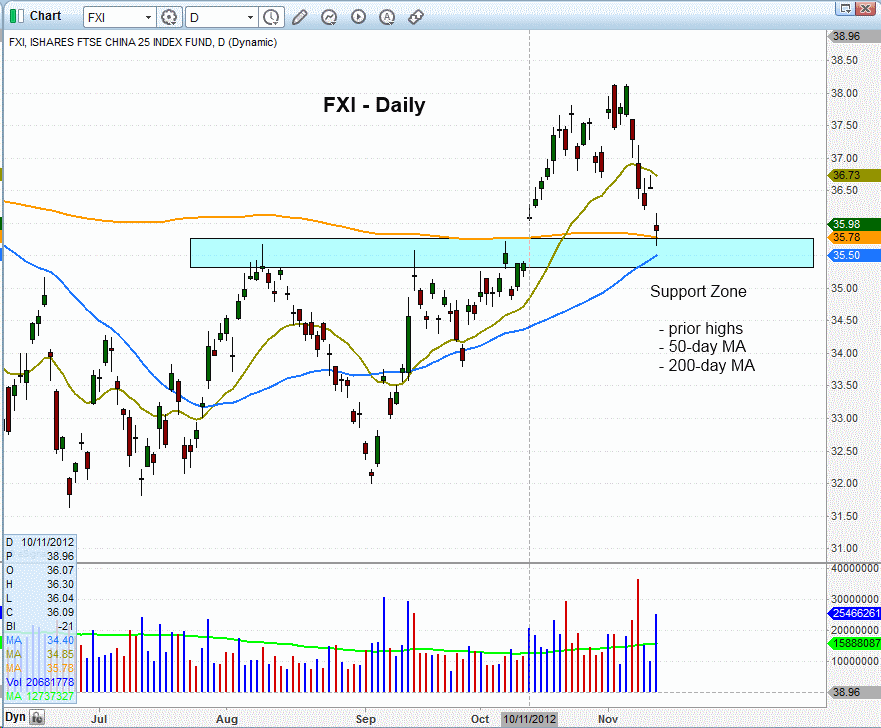Although our market timing system remains in “sell” mode, and our near to intermediate-term focus remains on the short side of the market, it’s never a bad idea to keep an eye on ETFs and stocks that are exhibiting relative strength to the broad market, as these will be the first equities to move higher when the broad market eventually finds support and bounces.
One of the very few ETFs showing relative strength since the two-month selloff in the US broad market began is iShares Xinhua China 25 Index Fund ETF ($FXI). Although the main stock market indexes of the USA have been in a downtrend since mid-September, FXI actually started trending higher just as the domestic markets started selling off. But despite its relative strength, FXI began correcting last week, and is now in pullback mode. However, this is still an ETF to consider buying if the stock market suddenly surprises us with a confirmed buy signal. Looking at the daily chart of FXI below, notice that FXI pulled back yesterday to close right at support of its 200-day moving average, following an extended run up from its October breakout. Support of the 200-day MA also coincides with new horizontal price support form the prior highs:

At the present time, we are NOT looking to buy FXI because the domestic broad market has yet to put in a convincing near-term bottom. Until it does, increasing or persistent bearish momentum in the US markets is likely to hold this ETF in check. Still, FXI should be on your watchlist as one of the first ETFs to consider buying when stocks eventually find a meaningful bottom. Therefore, it has been added to our internal watchlist as a potential long candidate, just in case our rule-based market timing model happens to shift back into “neutral” or “buy” mode any time soon.
High volatility and intraday indecision, such as was exhibited in yesterday’s broad market action, can be nerve-racking and frustrating for short-term swing traders. However, there is one benefit to such price action. Since stocks formed a similar intraday pattern (morning strength followed by afternoon weakness) on November 9, we now have two failed intraday rally attempts within the past three days. The benefit of this is that it makes it easy to adjust protective stop prices on short positions because if the main stock market indexes manage to rally above their three-day highs, bullish momentum will probably move stocks substantially higher in the near-term.
Presently, our model ETF trading portfolio is showing an unrealized gain of approximately $1,100 in trading profits (just over a 2% portfolio gain based on the $50,000 model account value). But because of the price action described above, we have now trailed the protective stops on our ETF and stock positions much tighter, so that we will still lock in substantial trading profit even if the major indices suddenly jump back above their three-day highs. Nevertheless, the weak action of the past three days also means there is an equally good chance that stocks could now tumble to new lows, due to the back to back failed reversal attempts (including the November 12 “inside day”). If that happens, our existing short and inverse ETF positions would realize substantially larger gains, and we would then immediately trail the protective stops even tighter, or look to take profits, the following day.
To be alerted to the exact and preset entry, stop, and target price of our best daily ETF and stock picks for swing trading, along with receiving access to our proprietary market timing system and Live Trading Room, subscribe to The Wagner Daily trading newsletter by clicking here. We assure your total satisfaction by offering a full money-back guarantee during the first 30 days.
